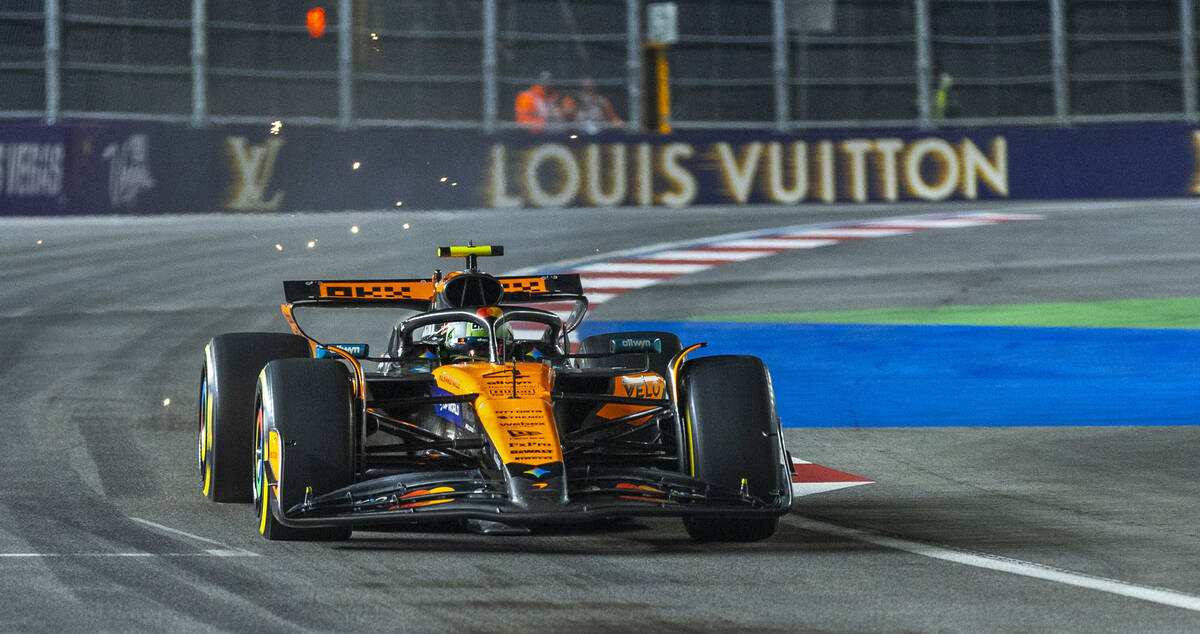Las Vegas Grand Prix gave the city a needed boost amid tourism slump, execs say
The Formula One Las Vegas Grand Prix is just what the city needed amid a mild tourism dip, the top executive at MGM Resorts said following the third-straight sellout event for open-wheel auto racing fans.
Bill Hornbuckle said having a major event like the race is something to look forward to each year, boosting visitation during what has typically been a slow time in Sin City.
“If you recall, this is the second or third most-worst weekend of the year, so to be able to put this injection into the community and the city and obviously for us at MGM Resorts for what we do at the (Bellagio) Fountain Club is a real boost, and we look forward to doing this for many, many years to come,” Hornbuckle told the Las Vegas Review-Journal.
Hornbuckle said that the race draws around 150,000 visitors who wouldn’t have come to Las Vegas for the week, if it were not for the three-day event. That tracked well for MGM Resorts, whose properties on the Strip boasted a 98 percent occupancy rate — while the resorts near the Bellagio Fountain Club were completely booked, Hornbuckle said.
“This time of year, you can’t ask for better than that,” he said.
Smoother operation
Las Vegas Convention and Visitors Authority CEO and president Steve Hill said all involved in putting on the race took the lessons of the first two grand prix events to ensure this year’s race weekend was the smoothest one yet.
“It’s just matured,” Hill said. “The logistics have been great. All the reports so far that I’m getting from the properties are that they’re having a terrific weekend.”
Actor Mark Wahlberg, a self-proclaimed full-time Las Vegas resident, said he believes the race is set up for future success in the city, after getting over the hump of the first two years of the event.
“I think people are really starting to gravitate towards it,” Wahlberg told the Review-Journal. “It’s bit of a slow build, because it’s not the most popular sport in America. But I think locals are even starting to appreciate it. People complained a lot about traffic and things of that nature, but it’s doing so much for the economy and so much for the city as a whole. So I think it will continue to grow. It’s nice to see every year, it’s got a nice, slow build. Which I think is going to make it a lot more sustainable.”
It will take a few months to know what type of economic impact the race weekend will have, but Hill said it will track around the $1 billion mark the first two races hit.
“From what I’m hearing, at least ($1 billion),” Hill said. “It’s not going to be below that number.”
With Las Vegas Grand Prix officials working to smooth community relations after a rocky first year due to 9 months of road disruptions, there was less negative commentary leading up to this year’s race.
“It wasn’t easy in year one; we’re thankful to the locals and their patience,” Hornbuckle said. “I think we all think we have it dialed in, and we’ll always get better. There’s a couple more issues that we still need to get resolved; but we will, because we’ve always have. Because it’s just too important. Too important to the city, actually for the country, it’s an amazing sport to bring here. … I think this has a long-term life, and we’re excited by it.”
Building a fan base
F1 lowered ticket prices by an average of 30 percent leading into the race, looking to attract the locals and visitors who might have put off going to the first two races due to the pricing. The third-straight sellout is testament to race organizers listening to the consumer, Hill said.
“I think they (F1) hit everything that they wanted to hit,” Hill said.
As was the case in the past, Thursday’s practice rounds saw fairly empty stands, with a visible increase on Friday for qualifying, despite steady rain for most of the session, and then full stands for the race on Saturday. Being able to draw a sizeable crowd during inclement weather on Saturday was a great sign for the race’s future.
“I was struck by that, too,” Hill said. “We’re developing fans of Formula One,” Hill said. “The folks stayed out in the rain to watch qualifying, and they weren’t going to let that deter them. They were awarded by a great qualifying session.”
Along with developing an F1 fan base, starting the race two hours earlier than the previous two races was also a key to this year’s success, Hill noted.
“If it’s raining and it’s 10 p.m., it’s not as attractive for people as it was at 8 p.m.,” Hill said. “I think both of those things probably played into that. Everybody feels really good about that earlier start time. I think it has helped the destination perform better, but it just feels like the right time in the evening to have the race.”
Built for major events
No other city in the world is better at hosting such large-scale events thanks to the city’s more than 120,000 hotel rooms, access to multiple airports and the ability to showcase the Strip during the race, according to Hornbuckle.
Hosting the race on the Strip also means one of MGM Resorts’ marquee properties, Bellagio, experiences significant disruptions for the assembly and tear down of the high-end hospitality space, Bellagio Fountain Club. The sidewalk and two lanes of Las Vegas Boulevard are blocked for about four months as crews to build and then dismantle the temporary structure built over the Fountains of Bellagio.
The months of obstruction of the Bellagio’s popular attraction, which carries a $12,500 per person ticket price, and is worth it to Hornbuckle, as the space serves as one of the main attractions each race for a worldwide audience, with F1 this year using it for a tie in with Disney, with Mickey Mouse featured in a performance over the water.
“Obviously for our high-end guests and our high-end corporate partners, it pays off,” Hornbuckle said. “We’ve been at this now for our third year, and we did invest a lot of money in what I call our big erector set out front here (of the Bellagio), so it takes a couple of months to bring up and take down. But it’s all worth it. It may seem for three days that it’s kind of crazy, and it is, but it is all worth it, I can promise you.”
Race’s future
With the continued success of race weekend, MGM Resorts and Caesars Entertainment this year reached new deals with F1 to extend their founding partnership deals with the race through 2030. The LVCVA and F1 are also already in talks to extend the race further than 2027, when the new two-year deal, which kicked in after Saturday’s race, expires.
The extension being discussed would be between five and 10 years, which would keep the race in Las Vegas on the weekend before Thanksgiving through as long as 2037.
“The investment that both Formula One and the community need to make in order to take the next step up requires a long-term contract,” Hill said. “You just can’t invest that kind of money and not know that there’s going to be enough years for it to be able to pay back.”
Contact Mick Akers at makers@reviewjournal.com or 702-387-2920. Follow @mickakers on X.























